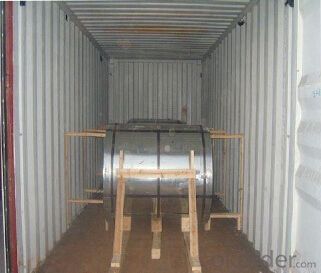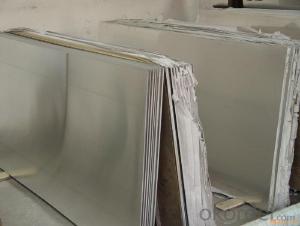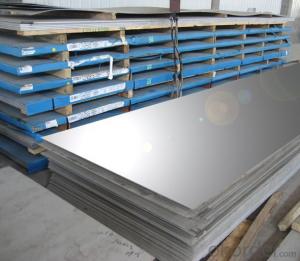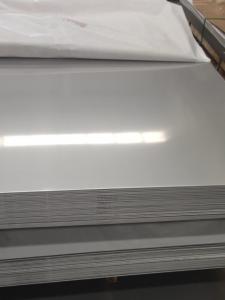Stainless Steel Plate 410 with No.4 Surface Treatment
- Loading Port:
- Shanghai
- Payment Terms:
- TT OR LC
- Min Order Qty:
- 500 m.t.
- Supply Capability:
- 5000000 m.t./month
OKorder Service Pledge
OKorder Financial Service
You Might Also Like
Hot sale stainless steel sheet 201/202/304/304l/310S/309S/316L/316Ti/316/316l/321,410/420/430/444/443/409L, and 904L.
Description of Stainless Steel Sheet:
Description | steel sheet,hot rolled steel sheet,cold rolled steel sheet, steel sheet,sheet,steel plate |
Standard | ASME, ASTM, EN ,BS,GB,DIN, JIS etc |
Application | Steel sheet applies to construction field, ships building industry, petroleum & chemical industries, war and electricity industries, food processing and medical industry, boiler heat exchanger, machinery and hardware fields. |
Packaging | Standard export sea-worthy packing |
Delivery time | 10-30 days |
Quality | No.1 |
Productivity | 500 tons/Day |
Note | Our company has cooperative relation between the domestic agents. Stainless steel sheet can be made accordingto the customers requirements. Fasten delivery. Quality assured. |
Contacts | If you have any question,please feel free contact me. |
Stainless steel sheet surface finish characteristics
Surface finish | Characteristics and application |
2B | The surface brightness and flatness of no2B is better than no2D. then through a special surface treatment to improve its mechanical properties,No2B could nearly satisfy comprehensive uses. |
No.1 | Polished with abrasive belt of grit#100-#200, have better brightness with discontinuous coarse stria, used as inner and external ornaments for building, electrical appliances and kitchen utensils etc. |
No.4 | Polished with abrasive belt of grit #150-#180,have better brightness with discontinuous coarse stria, but thinner than No3, are used as bathtub buildings inner and external ornaments electrical appliances kitchen utensils and food processing equipment etc. |
HL | Polished with abrasive belt of grit #150-#320 on the NO.4 finish and has continuous streaks, mainly used as buildings ornaments elevators, door of building, frontal plate etc. |
BA | Cold rolled, bright annealed and skin-passed, the product have excellent brightness and good reflexivity like mirror, kitchen apparatus, ornament etc. |
8K | The product have excellent brightness and prefer reflexivity can to be the mirror. |
Main Features of stainless steel sheet :
•Escalator, Elevator, Doors
•Furniture
•Production tools, Kitchen appliances, freezers, cold rooms
•Auto Parts
•Machinery and Packaging
•Equipment and Medical devices
•Transport system
Product Details:



Sandard Seaworth Packing(wooden packing with water proof paper)


FAQ:
1. What's the quality?
very fine
2. How long get reply?
within 24 hours
If you have any question about stainless steel sheets,donot forget to sending the email to Us! You will get the competitive Price and have a very good experience about the Buying Process! CNBM International Corporation is always your trustful friend!
- Q: Can stainless steel sheets be used for power generation equipment?
- Yes, stainless steel sheets can be used for power generation equipment. Stainless steel is a highly durable and corrosion-resistant material, making it suitable for various applications in power generation, including turbine blades, heat exchangers, and electrical enclosures. Its high strength-to-weight ratio and resistance to extreme temperatures make it an ideal choice for reliable and long-lasting power generation equipment.
- Q: What is the price per square foot for stainless steel sheets?
- The cost of stainless steel sheets per square foot can fluctuate due to different factors, including the grade, thickness, finish, and supplier. Generally, the price range for stainless steel sheets is $3 to $10 per square foot. Nevertheless, superior quality and specialty options may have a higher price, reaching $20 or even more per square foot. Considering these variables and exploring different options is crucial in order to find the most suitable price for your specific needs.
- Q: Stainless steel plate glued to tiles, what glue?
- Depending on the size of the material and the number of adhesive areas, you can choose a different glue, the same function of glue, you should compare the quality and price of glue. Before you recommend what glue to use, you should first identify the following questions to choose the right glue.
- Q: What are the different finishes available for stainless steel sheets?
- Stainless steel sheets come in various finishes, each offering a distinct appearance and level of protection. 1. The most basic and commonly used finish for stainless steel sheets is No. 1 Finish. It is achieved through hot-rolling, resulting in a rough and dull surface with visible grain lines. This finish is typically utilized in industrial applications where aesthetics are not a primary concern. 2. For a brighter and slightly reflective finish, No. 2B Finish is preferred. This cold-rolled finish boasts a smooth surface with a matte appearance, making it ideal for decorative purposes like architectural applications or kitchen appliances. 3. No. 4 Finish, also known as brushed or satin finish, possesses a distinctive look due to its fine polishing grit lines. It is commonly used for decorative applications, such as elevator doors or trim, as it can effectively conceal minor surface imperfections. 4. If a highly reflective finish is desired, No. 8 Mirror Finish is the way to go. It offers a smooth and shiny surface akin to a mirror's polish. This finish is commonly chosen for decorative purposes like architectural features or decorative trim. 5. The Hairline Finish provides a refined and elegant appearance with its fine, brushed texture resembling hair grain. It is commonly employed in decorative and architectural applications. 6. To add texture and visual interest to stainless steel sheets, the Embossed Finish is created through embossing or stamping, resulting in a pattern or design on the surface. This finish is often used for decorative purposes. It is important to note that the availability of these finishes may vary depending on the supplier and the specific grade of stainless steel being used.
- Q: How do I prevent warping on stainless steel sheets?
- In order to avoid warping on stainless steel sheets, there are several actions one can take: 1. Adequate storage: Store stainless steel sheets in a dry, flat, and well-ventilated area. Avoid storing them in areas with high humidity or dampness, as moisture can cause warping. 2. Gentle handling: When moving or handling stainless steel sheets, employ proper lifting techniques to minimize strain on the material. Avoid dropping or mishandling the sheets, as this can result in warping. 3. Precise cutting and shaping: When cutting or shaping stainless steel sheets, utilize appropriate tools and techniques to ensure clean and accurate cuts. Avoid applying excessive force or using incorrect cutting methods, as this can lead to warping. 4. Controlled heat application: During welding or other heat-related processes, it is crucial to control the application of heat. Excessive heat or uneven heating can cause warping. Employ proper techniques, such as preheating the material or using heat sinks, to evenly distribute heat and reduce the risk of warping. 5. Avoid excessive load: Do not overload stainless steel sheets with excessive weight or pressure. Ensure that the load is evenly distributed to prevent deformation and warping. 6. Cooling process: After any heat-related processes, allow the stainless steel sheets to cool down slowly and naturally. Avoid rapid cooling methods, such as water quenching, as this can cause uneven contraction and result in warping. 7. Quality assurance: Ensure that the stainless steel sheets you purchase are of high quality and meet the required standards. Inferior quality materials may possess inherent defects that can cause warping. By adhering to these preventive measures, one can minimize the likelihood of warping on stainless steel sheets and preserve their integrity and quality.
- Q: Are stainless steel sheets suitable for cryogenic storage tanks?
- Yes, stainless steel sheets are suitable for cryogenic storage tanks. Stainless steel has excellent mechanical properties and high resistance to corrosion, making it an ideal material for storing low-temperature substances in cryogenic conditions.
- Q: Can stainless steel sheets be used in the medical industry?
- Yes, stainless steel sheets can be used in the medical industry. Stainless steel is highly resistant to corrosion and is known for its durability and strength. It is commonly used in medical equipment, surgical instruments, implants, and even in the construction of medical facilities. Its non-reactive and easy-to-clean properties make it suitable for medical applications, ensuring the safety and hygiene of patients.
- Q: Is there any magnetism in 304 stainless steel?
- The magnetic material itself is not magnetic, because of some processing reasons, resulting in magnetic, but its relatively weak magnetic, and other carbon steel material is still different. 304, the magnetic properties of stainless steel is weak magnetic, if it is strong magnetic, it is not true 304 stainless steel.
- Q: What are the different types of stainless steel sheet alloys?
- Stainless steel sheet alloys come in various types, each possessing unique properties and characteristics. Below are some of the commonly used types: 1. Austenitic stainless steel, the most widely used alloy, is known for its excellent formability and high corrosion resistance. Industries like food processing, pharmaceuticals, and architecture often use grades like 304 and 316. 2. Ferritic stainless steel, which has a higher carbon and lower chromium content compared to austenitic steel, offers good corrosion resistance and high strength. It finds applications in areas requiring high temperature resistance, such as automotive exhaust systems. 3. Martensitic stainless steel alloys, with higher carbon and lower chromium content than both austenitic and ferritic steels, are valued for their high strength, hardness, and corrosion resistance. They are commonly used in cutlery, surgical instruments, and turbine blades. 4. Duplex stainless steel combines the properties of austenitic and ferritic steels, providing a balance between strength and corrosion resistance. It is widely used in chemical processing, oil and gas, and marine industries. 5. Precipitation-hardening stainless steel is heat treatable and can achieve high strength and hardness through a precipitation-hardening process. It is critical in aerospace and defense applications that require both strength and corrosion resistance. These examples represent only a fraction of the available stainless steel sheet alloys. The choice of alloy depends on specific application requirements, such as corrosion resistance, strength, and temperature resistance.
- Q: Is the cold rolled steel plate good or the stainless steel plate?
- The cold rolled steel itself, whether washed by acid car wash, semi-finished products, or rolled out by cold rolling mill semi-finished products, their rust resistance is very poor. It is easy to oxidize, resulting in rust on the surface of the air. It will not rust until it has been plated with aluminum or zinc, and it is clear that the process is complex and unsafe.
Send your message to us
Stainless Steel Plate 410 with No.4 Surface Treatment
- Loading Port:
- Shanghai
- Payment Terms:
- TT OR LC
- Min Order Qty:
- 500 m.t.
- Supply Capability:
- 5000000 m.t./month
OKorder Service Pledge
OKorder Financial Service
Similar products
Hot products
Hot Searches
Related keywords


































